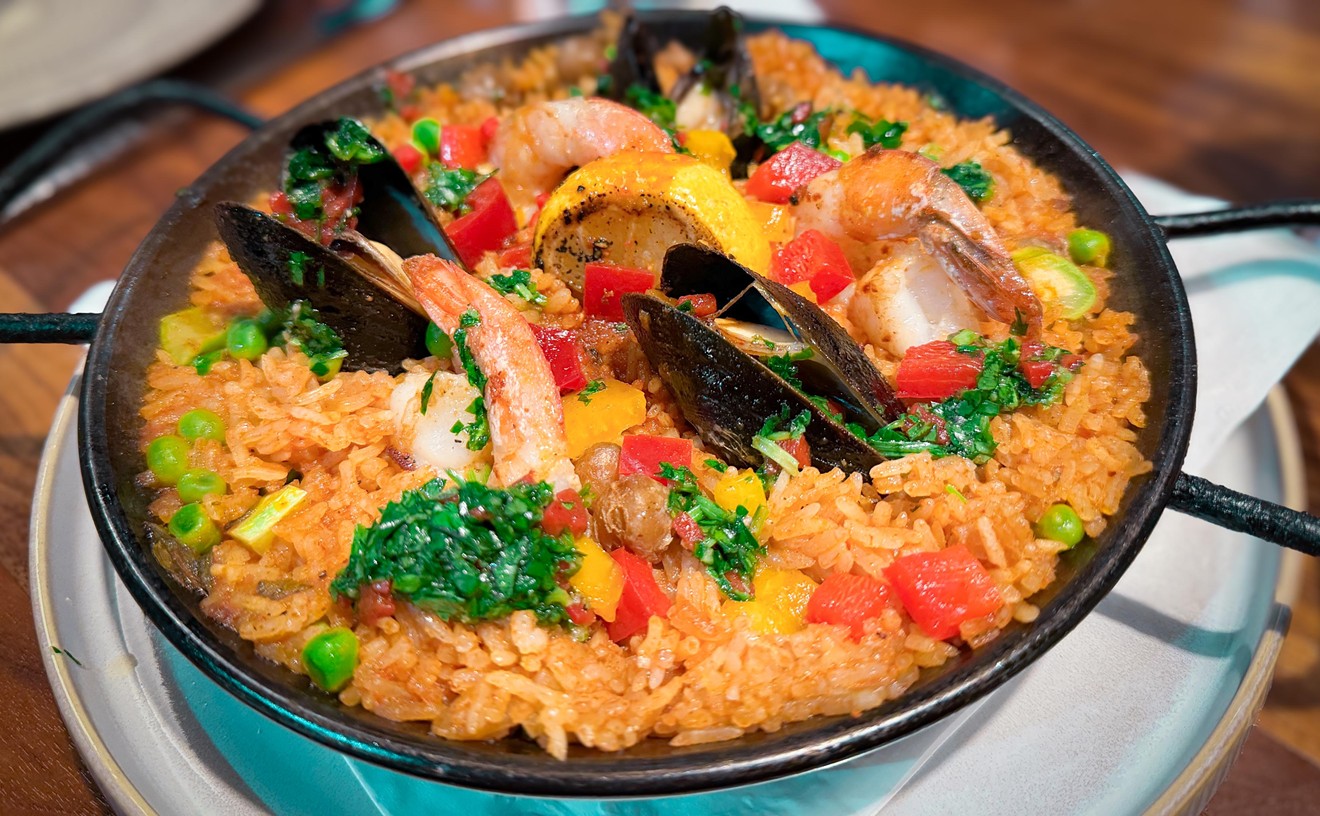Now finding a man's head in the belly of a shark or a Dallas gold digger might not be that unusual, but a cod is not a vicious predator. At any rate, the fish was taken away in a body bag by police, who are conducting a forensic investigation of the cod and the noggin. They suspect the head belongs to a fisherman who disappeared off a fishing trawler at sea, although one hopes he fell in and wasn't snatched off the deck by the fish. But a lingering question remains. How did the head get severed?
Sushi Yokohama, a clean, warm sushi bar in the same strip mall as the French restaurant Lavendou, offers diners an ample chance for a little interspecies payback for that headless victim. By ample, I mean the strips of fish planted on the rice pads. They're massive, dwarfing the little wads of rice upon which they're spread. Mud flaps of fish dangle off both ends of the rice and drape onto the wooden serving trays. Long, thick, half-moon slices of octopus sheets show just a slight bump in the center where the tightly packed rice resides. It's almost scary how vast and visually indelicate this sushi is.
The fear quickly dissipates once the fish is slipped into the mouth, making this perhaps the best sushi deal, on a gram-per-penny basis, in North Texas. Though oversized, everything is artful and carefully orchestrated here. Plush blood-rose strips of maguro (tuna) are satiny, cool, and delicate. Thick glistening planks of hamachi (yellowtail) are tender, clean, and nutty--almost sweet on the tongue. The chewy taco (octopus) was firm, never veering into spongy rubberiness. Even the smoked salmon was carved into a brilliant display. Fanned flakes of flesh stretched across the rice roll like a row of gills, melting into a slick of smokiness in the mouth. The only example from this sushi bar that faltered was the uni (sea urchin roe), which was pale, runny, and a little bland, though on a subsequent visit it was firmer and flush with a rich nutty flavor.
Even when assuming ridiculously thick and broad proportions, as it did in the maguro sashimi, the flesh still disintegrated in the mouth, the smooth unfurling not marred by sinuous snags. Other servings were good too. A small salad delivered shortly after seating--a collage of cucumber, rice noodles, octopus, and sesame seeds splashed in a soy dressing--was balanced and robust. Knots of pickled ginger were brisk and succulent, though the scarcely sweet miso soup was a bit watery. Edamame (fresh soy beans in the pod) was tender and nutty.
Sushi Yokohama is briskly minimalist with lots of blond wood, a Pergo floor, and clusters of large, tightly fitted tiles arranged in patterned rectangles on the walls. One of the clusters was strangely recognizable. The grid was composed of fiberglass tiles with fossil-like impressions of bees, dragonflies, and butterflies, tiles that are sold at Home Depot as garden steppingstones. Maybe this is an example of fierce resourcefulness, or perhaps whimsy. There are other things to indicate the latter is the case. Behind the sushi bar is a tall Plexiglas cylinder filled with water that bubbles and prods cartoonish plastic fish up and down along its length. These gizmos creep up here and there at Asian restaurants across the metroplex. It's hard to know why. Maybe they're the appropriate alternative to the 30-gallon koi tank in some minds, the type of mind that ends up in a cod gullet.
My cold sake was delivered with a thick square shot glass that had "Wathen's Kentucky Bourbon" tattooed on its surface. It seemed odd to be sipping sake out of a bourbon glass while watching plastic fish ride bubbles up and down on the back bar. As I sipped, I watched one of the sushi chefs carefully and deliberately--with the mindfulness he displayed separating a hunk of tuna muscle into vigorous sashimi segments--fill a decorative bowl with water. He approached a narrow metal water wall directly behind the bar and poured the water into the reservoir, running his eyes over the dribbling metal panel and smiling.
My chirashi arrived as the water flow swelled. This voluptuous bowl of assorted raw fish and vegetables was crowded obscenely over rice laced with seaweed. Strips of cucumber and broad shingles of tuna, salmon, hamachi, mackerel, and octopus filled the dish like a heaping bowl of fleshy Chex snack mix. It was all fresh and silky, as if the stuff had gone directly from the trawler hook to my lips. Even the Japanese grub with the least fetishist appeal was good. Salmon teriyaki is succulent and luscious with a smooth, deft sauce that never descends into cloying insipidity. Sushi Yokohama is good enough to lose your head over. And they don't even serve cod.










